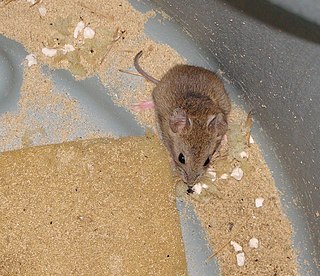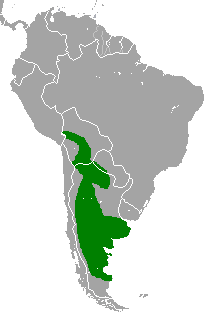
The rodent subfamily Sigmodontinae includes New World rats and mice, with at least 376 species. Many authorities include the Neotominae and Tylomyinae as part of a larger definition of Sigmodontinae. When those genera are included, the species count numbers at least 508. Their distribution includes much of the New World, but the genera are predominantly South American, such as brucies. They invaded South America from Central America as part of the Great American Interchange near the end of the Miocene, about 5 million years ago. Sigmodontines proceeded to diversify explosively in the formerly isolated continent. They inhabit many of the same ecological niches that the Murinae occupy in the Old World.
The large vesper mouse is a South American rodent species of the family Cricetidae.

The small vesper mouse is a rodent species from South America. It is found in Argentina, Bolivia, Brazil, Paraguay and Uruguay. It is one of the hosts of hantavirus, causing hantavirus pulmonary syndrome
The delicate vesper mouse is a South American rodent species of the family Cricetidae. It is found in Argentina, Bolivia and Brazil. Its karyotype has 2n = 66 and FN = 66.
The Tocantins vesper mouse is a South American rodent species of the family Cricetidae. It is found in Brazil. Its karyotype has 2n = 46 and FNa = 66.

Vesper mice are rodents belonging to a genus Calomys. They are widely distributed in South America. Some species are notable as the vectors of Argentinian hemorrhagic fever and Bolivian hemorrhagic fever.
The Bolivian vesper mouse is a species of rodent in the family Cricetidae. It is found in Argentina, Bolivia and perhaps Peru.

Hummelinck's vesper mouse is a species of rodent in the family Cricetidae. It is found in Aruba, Brazil, Colombia, the Netherlands Antilles, and Venezuela.
The Andean vesper mouse is a species of rodent in the family Cricetidae. It is found in Argentina, Bolivia, Chile, and Peru.

The drylands vesper mouse is a species of rodent in the family Cricetidae. It is found in Argentina and Paraguay.
The Peruvian vesper mouse is a species of rodent in the family Cricetidae. It is found only in Peru.
The caatinga vesper mouse is a rodent species in the family Cricetidae from South America. It is endemic to eastern Brazil, where it is found in open savanna (cerrado) and thorny scrub (caatinga) habitats. Its karyotype has 2n = 66 and FN = 68. It was formerly synonymized with C. callosus, but the latter has 2n = 50 and FN = 66. Karyologic analysis of C. expulsus has shown that the X chromosome is large and submetacentric while the Y chromosome is either acrocentric or submetacentric. Predators include the barn owl. Sexual dimorphism in shape and size occurs; the former is present mainly before the age of 20 days. Males are smaller before age 50 days and larger thereafter, which becomes less prominent after 200 days.
The Córdoba vesper mouse or Córdoba laucha is a South American rodent species of the family Cricetidae. It is endemic to the area of Córdoba Province, central Argentina, where it is found in the espinal.
The fecund vesper mouse is a species of rodent in the family Cricetidae. It is known only from Bolivia, where it is found in the yungas and Tucumano boliviano forest ecoregions at elevations from 600 to 2700 m. It is regarded by some authorities as conspecific with C. boliviae, and by some as conspecific with C. venustus, despite having a karyotype with 2n = 54 while C. venustus generally has a karyotype with 2n = 56.

Juliomys anoblepas is a rodent in the genus Juliomys of the subfamily Sigmodontinae known from a single broken skull. The specimen was collected by Peter Wilhelm Lund in the caves of Lagoa Santa, Minas Gerais, Brazil, in the first half of the 19th century and described by Herluf Winge in 1888 as Calomys anoblepas. The species remained unstudied and its affinities unclear until 2011, when it was recognized as a member of the genus Juliomys, which includes three other species from southern Brazil and nearby Argentina and Paraguay. J. anoblepas is probably a separate extinct species of the genus, which is no longer found at Lagoa Santa.

NGC 3610 is an elliptical galaxy in the constellation Ursa Major. It was discovered on 8 April 1793 by William Herschel.

Urva is a genus comprising the Asian mongooses within the mongoose family Herpestidae. Species in the genus were formerly classified in the genus Herpestes, which is now thought to comprise exclusively African mongooses; phylogenetic evidence indicates that the Asian mongooses form a monophyletic group and had an Asian common ancestor. Urva forms a clade with Xenogale and Atilax, while Herpestes forms a clade with all other African mongoose species.






